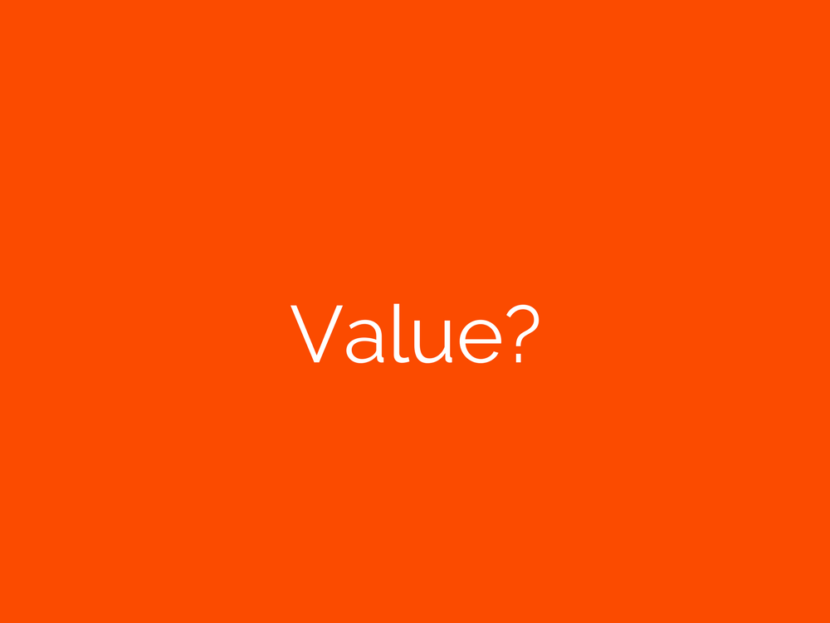Over the last few days I’ve been contemplating the meaning of ‘value’ as it pertains to brands.
I believe that value is at the heart of business, and therefore it’s marketing.
Value is only created when benefits outweigh the cost.
It is the exchange of a value that creates trade: I give you something of value and you give me something I value in return.
Understanding value is critical to commerce.
There are different types of value because the entities making the exchange each have a different perception of the benefit and cost.
Functional, Monetary, Social, Psychological and even Spiritual values differ in perceived benefits and the ‘price’ paid.
That’s why value is always perceived by the recipient, not the giver.
For a brand to have value it must have one or more of these benefits and a price must have been paid.
Therefore a brand is something created by the recipient of the benefit e.g. a customer.
The larger the perceived benefit : cost ratio the more value is created. And, potentially, the more valuable the brand.
Beyond the functional benefits of a product or service it is in the marketing of the brand that marketers create perceived benefits, and therefore the value.
Perceived value can and does change over time, in different markets, and in different cultures – because people change.
Brands have to manage the perceived value and the cost to create that value.
It is often easier to lower the price than increase the perceived benefits.
But pricing is a mathematical exercise: The numbers are crunched and the margins calculated. The real art of creating value is increasing the perceived benefits.
How can brands increase the perceived benefits?
Bain & Company identified 30 elements of value in their Harvard Business Review article in September 2016 (The Elements of Value – Eric Almquist John Senior Nicolas Bloch https://hbr.org/2016/09/the-elements-of-value). They put these elements into four categories: functional, emotional, life-changing and social impact. These elements build on Maslow’s hierarchy of needs.
Manfred Max-Neef, the Chilean economist, proposed a different set of human needs (subsistence, protection, affection, understanding, participation, leisure, creation, identity & freedom), and they also broadly fit into the four categories Bain&Co put forward. (For me, all the elements of value fall into functional and / or emotional need).
It is less important which theory is followed than the idea of need.
Understanding what the perceived need of a customer is, and meeting that need is ‘the benefit’ in our value equation.
Understanding the price willing to be paid is where the value is created.
The ‘value proposition’ we hear talked about in business is the value created by the promise of meeting the perceived benefit for the right price.
Meeting the need with a benefit can be a complex and sophisticated process.
Marketers can, do and should blend benefits into their proposition: both functional and emotional.
A brand can satisfy a multitude of perceived needs, but when it combines the categories it creates higher value.
For example, a car will get you from A to B (functional), a car can be electric or hybrid and be more environmentally conscious (social impact), a car can evoke a strong feeling when driven (emotional) and a car can be a symbol of self-actualisation (life-changing).
E.g. A Toyota Prius satisfies some of the perceived needs, but because the Ferrari La Ferrari satisfies all of them it can command a much higher margin.
In the article above, Bain & Co tested the theory on loyalty and for growing revenue.
Their first hypothesis was that the ‘companies that performed well on multiple elements of value would have more loyal customers than the rest’. The survey confirmed that.
Companies with high scores on four or more elements of value had, on average, three times the NPS of companies with just one high score, and 20 times the NPS of companies with none.
Their second hypothesis was that ‘companies doing well on multiple elements would grow revenue at a faster rate than others’.
They found companies that scored high on four or more elements had recent revenue growth four times greater than that of companies with only one high score.
So there is value in value.
They also found that not all elements of value are equal in all categories.
What customers value in products varies by industry.
Here are the top five elements influencing loyalty for 4 of the 10 types of businesses they analysed.
Apparel Retail
- Quality
- Variety
- Avoids Hassles
- Design/Aesthetics
- Saves Time
Consumer Banking
- Quality
- Provides Access
- Heirloom
- Avoids Hassles
- Reduces Anxiety
Grocery
- Quality
- Variety
- Sensory Appeal
- Reduces Cost
- Rewards Me
Food And Beverages
- Quality
- Sensory Appeal
- Variety
- Design/Aesthetics
- Therapeutic Value
The concept of ‘quality’ as a benefit is common to all 10 categories. It is a hygiene element.
In 8 of the categories ‘variety’ was also an important element.
Quality and variety are subjective: ‘Perceived’ quality and ‘perceived’ variety.
Because the benefits are ‘perceived’, the concept of value is deeply psychological.
However by using an understanding of human needs we can make value much less vague and enigmatic.
By combining the perceived benefits marketers can creatively add value to their brands and thereby gain an edge with consumers — the true arbiters of value. The arbiters of brand.
So what has this got to do with a ‘communications agency’.
We add value to our clients by creating or shifting perceptions of benefits in meeting perceived needs.
We increase the value of their brands through insight, ideas and implementation of creative communications.
If you want more value from your marketing ask someone that understands value.

